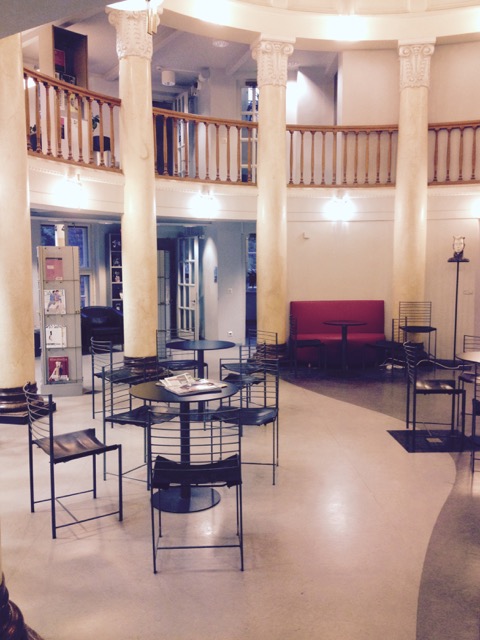Finding a good study place is a struggle every student is familiar with. As the first exam week approaches the seats at the university library Kaisa are occupied from dawn and vigorously guarded until closing time. Such is life that the early bird gets the worm, and as a googly-eyed night owl, I have no hope gaining a coveted seat at Kaisa. Public libraries come to the rescue for students such as myself. I first came across the Kallio library in a search for an alternative study space. With individual workstations, with plug-ins for computers, along the walls on both the first and second floor, in addition to a reading area and a separate study room, it has proven to be more than adequate for my study needs. But it’s good to keep in mind that libraries are public spaces, where people are constantly coming and going. Not everyone is going to aware of how loudly they are humming to themselves or requesting a Lonely Planet Guide to Italy.
The three- storey beaut of a building, known as the Kallio library, stands proudly right in the centre of Helsinki’s Hipsterville. It is the recreational oasis for quite a motley crew, to say the least. It’s just as much the favourite of the bums, who read the daily paper and stumble across the street to Las Vegas (one of Kallio’s finest ale-houses), as it is of the pouty art high-school students, the city-moms who are religiously into Nordic design, and the elderly folk with suspiciously persistent coughs.

The Kallio library is a feast for the eyes. It represents late art nouveau architecture spiced with classical features. As you enter through the doors, you are met with a line of pillars directing the gaze to an adorable reading hall at the back of the library, where natural light floods through the rows of paned windows, inviting you to venture further in. This two-storey hall with an impressive dome ceiling is the heart of the library: the centre of activity. Kallio library hosts different events almost daily. The high ceiling invites chatter and laughter to echo in the corners. The sounds of every day life resonate on the walls.
Numerous afternoons spent typing up essays and cramming for exams at the Kallio library have prompted me to consider the significance of the institutions themselves. One afternoon, having been distracted from my work by a man muttering gibberish to himself, I reached a conclusion. Libraries stand for what is best about a community; we all contribute to give everyone the opportunity to access knowledge, to develop skills and comingle with people outside of our social circles. As free public service providers, libraries offer much more than free books. They are mediums of knowledge, culture and social cohesion.
Last spring a Helsingin Sanomat -article about “social bubbles” generated spirited conversation on social media sites. The article drew attention to the fact that we are all susceptible to biases based on the norms of our social circles. And it’s perceivable in how rarely we willingly spend extended periods of time in the same vicinity with people outside our socio-economic circles. This issue gains a much larger and relevant context in reference to the current influx of migrants in Europe. The risk being that whole communities find themselves pushed to the margins of society, unable to integrate into a strange new community. Social and cultural exchange plays a crucial role in integration, but it needs a venue of some sort. In a community that seems to be increasingly fragmented, I find solace in the fact that at libraries seeing an exhaustive cross-section of the demographic is still the norm, and so, libraries provide an opportunity to experience the richness and diversity of society.
The Kallio library is one of 71 Helsinki Metropolitan Area Libraries (Helmet), which all organize weekly programs, clubs, public readings, workshops and cultural events. These events--open to everyone--cultivate cultural and social cohesion. Language cafés and reading groups promote cultural exchange and integration. Children’s story times and homework groups support literacy and language acquisition. Poetry readings, handicraft workshops and book clubs abate the loneliness that elderly people often face. Socializing and integration is the fortunate by-product of joined activity.
In addition to cultivating culture and community, libraries provide free access to information and recreation. The Helmet libraries offer a variety of other items to borrow and use in addition to books: audiobooks, DVD’s, music, board games and a miscellaneous bunch of other items varying from party costumes to a drill bit kit. A few summers ago my friends and I were able to organize monthly baseball matches thanks to the Leppävaara library’s baseball gear. Helmet online services include language courses, over 6000 movies on IndieFlix, and an extensive research database. I won’t get carried away with the services, but I will tell you that you can turn to the library for all your 3D-printing and -scanning, laminating, sewing, video editing and graphic designing needs. Oh, and the Rikhardinkatu library lends paintings, in case you ever entertain snobby guests only impressed by an art collection.
Libraries are essentially communal living rooms and should receive recognition for a number of things: inspiring aesthetics, eccentric clientele, extensive resources and a wide selection of pastime activities, but I think libraries deserve an extra round of applause for what they stand for in a society: the sense of community and the equal opportunity to acquire knowledge for its own sake.
Ps. The Rikhardinkatu library, which, by the way, is absolutely stunning, hosts a Shakespeare book club every Wednesday from 6 to 8 pm. I’m just going to leave that information out there for all you Shakespeare fanatic English students.
